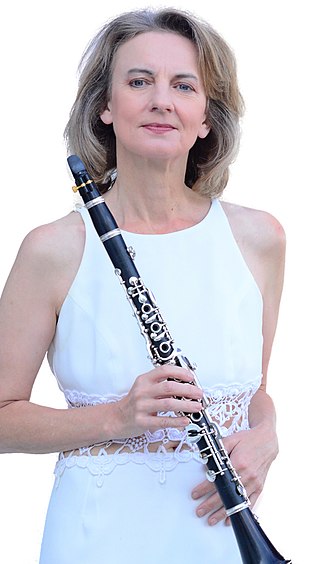Clarinet Concerto is any concerto for clarinet.
Clarinet Concerto may also refer to:

In music, a cadenza is, generically, an improvised or written-out ornamental passage played or sung by a soloist or soloists, usually in a "free" rhythmic style, and often allowing virtuosic display. During this time the accompaniment will rest, or sustain a note or chord. Thus an improvised cadenza is indicated in written notation by a fermata in all parts. A cadenza will usually occur over either the final or penultimate note in a piece, the lead-in, or the final or penultimate note in an important subsection of a piece. It can also be found before a final coda or ritornello.

The basset horn is a member of the clarinet family of musical instruments.

The basset clarinet is member of the clarinet family similar to the usual soprano clarinet but longer and with additional keys to enable playing several additional lower notes. Typically a basset clarinet has keywork going to a low (written) C or B, as opposed to the standard clarinet's E or E♭. The basset clarinet is most commonly a transposing instrument in A, although basset clarinets in C and B♭ and very seldom in G also exist. The similarly named basset horn is also a clarinet with extended lower range, but is in a lower pitch ; the basset horn predates, and undoubtedly inspired, the basset clarinet.

A clarinet concerto is a concerto for clarinet; that is, a musical composition for solo clarinet together with a large ensemble. Albert Rice has identified a work by Giuseppe Antonio Paganelli as possibly the earliest known concerto for solo clarinet; its score appears to be titled "Concerto per il Clareto" and may date from 1733. It may, however, be intended for soprano chalumeau. There are earlier concerti grossi with concertino clarinet parts including two by Johann Valentin Rathgeber, published in 1728.

Thea Musgrave CBE is a Scottish composer of opera and classical music. She has lived in the United States since 1972.

Sabine Meyer is a German classical clarinetist.
Aaron Copland's Clarinet Concerto was written between 1947 and 1949, although a first version was available in 1948. The concerto was later choreographed by Jerome Robbins for the ballet Pied Piper (1951).

Jonathan Cohler is an American classical clarinetist, conductor, music educator and record producer.
Concerto No. 2 may refer to:

Sharon Kam ; born August 11, 1971, is an Israeli–German clarinetist. She won the ARD International Music Competition in 1992.
Karol Szymanowski’s Violin Concerto No. 1, Op. 35, is considered one of the first modern violin concertos. It rejects traditional tonality and romantic aesthetics.
The Clarinet Concerto is a concerto for clarinet and orchestra by the American composer Christopher Rouse. The work was commissioned for the Chicago Symphony Orchestra and its principal clarinetist Larry Combs by the Institute for American Music. It was completed December 11, 2000 and premiered May 17, 2001 at Symphony Center in Chicago with Christoph Eschenbach conducting the Chicago Symphony Orchestra. The piece is dedicated to Rouse's friend and fellow composer Augusta Read Thomas.
The Duet-Concertino for clarinet and bassoon, TrV 293, with string orchestra and harp in F major, was written by Richard Strauss in 1946/47 and premiered in 1948. It is the last purely instrumental work he wrote.
In music, Op. 26 stands for Opus number 26. Compositions that are assigned this number include:
Clarinet Concerto No. 1 may refer to:
Clarinet Concerto No. 2 may refer to:
The bassoon repertoire consists of pieces of music composed for bassoon as a principal instrument that may be performed with or without other instruments. Below is a non-exhaustive list of major works for the bassoon.
In music, Op. 73 stands for Opus number 73. Compositions that are assigned this number include:
In music, Op. 88 stands for Opus number 88. Compositions that are assigned this number include:
In music, Op. 115 stands for Opus number 115. Compositions that are assigned this number include: